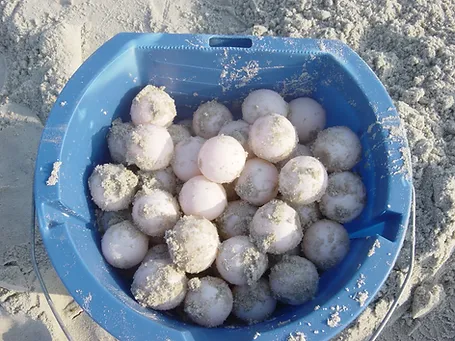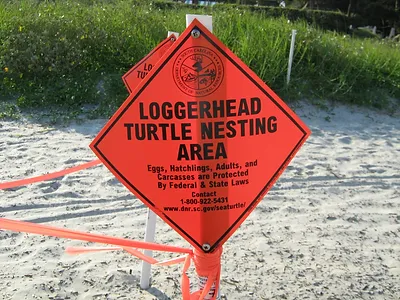Life of A Loggerhead
Learn All About Sea Turtles on Hilton Head Island.

THE EGGS & INCUBATION
The 400-pound mother loggerhead emerges from the sea and drags herself up the beach to the dry sand. She digs an egg chamber for approximately 120 eggs with her back flippers. The eggs are soft and leathery and do not break when they are dropped into the 2-foot deep egg chamber. The temperature in the nest determines the gender of the hatchlings.
HATCHING & EMERGENCE
The eggs will hatch under the sand after about 60 days. The hatching process takes about three days inside the egg chamber. In the cool temperature of the evening after sunset, the hatchlings will emerge from the nest chamber by crawling through about a foot of sand. Because they are reptiles, they cannot control their body temperature. They will emerge when temperatures are cooler in the evenings instead of during the heat of the day.


ENTERING THE WATER
A hatchling’s journey begins with crawling toward the beach toward the ocean’s open horizon and into the waves that roll onto shore. At night the reflection of the moon on the water directs them into the surf. They know to swim into the open ocean out 70 miles to the Gulf Stream, which takes approximately 3 days. It is estimated that one out of 100 hatchlings will make it safely to the Gulf Stream.
RIDING THE GYRE
The Gulf Stream provides shelter in the sargassum weed that floats in it. There are plenty of small organisms that the hatchling can feed on. They will rest for a time and float north in the current of the North Atlantic Gyre. When they are rested, they will swim with the current and cross the Atlantic. Their destination is an isolated island chain off of the coast of Portugal called the Azores, and it could take them up to a year to get there! They stay there for many years.


THE JOURNEY BACK HOME
When they are about 10-15 years old, sea turtles are about 2.5-feet long and will grow very slowly for the rest of their lives. At this age, they instinctually find the North Atlantic Gyre again and follow it all the way back across the Atlantic to the Eastern seaboard of the United States. They find a spot that provides adequate food and forage until they are approximately 30 years old.
NESTING
The male loggerheads will never come back to shore, but the females will become sexually mature around the age of 30. They will find the Earth’s magnetic signature that they imprinted during their first journey as a hatchling to the Gulf Stream and return to that area. Hatchlings entering the ocean in Georgia, South Carolina, and North Carolina will consider any beach in all three states to be the “beach that they were born on”. During a nesting summer, a female can lay five or six nests. She will lay a nest with an average of 120 eggs every two weeks anywhere in her natal beach area.

SEA TURTLE PATROL HILTON HEAD ISLAND
2024 Season: The Next Generation
2024 Nesting season Statistics
2023 Nesting season Statistics
learn more about sea turtles
frequently asked questions
Stay in touch
SAVING SEA TURTLES
Want to learn more about how you can help the sea turtles visiting Hilton Head Island? Join our mailing list and receive up-to-date information on nesting and our Patrol activities throughout the year.
Click Here to Sign Up for our Newsletter
